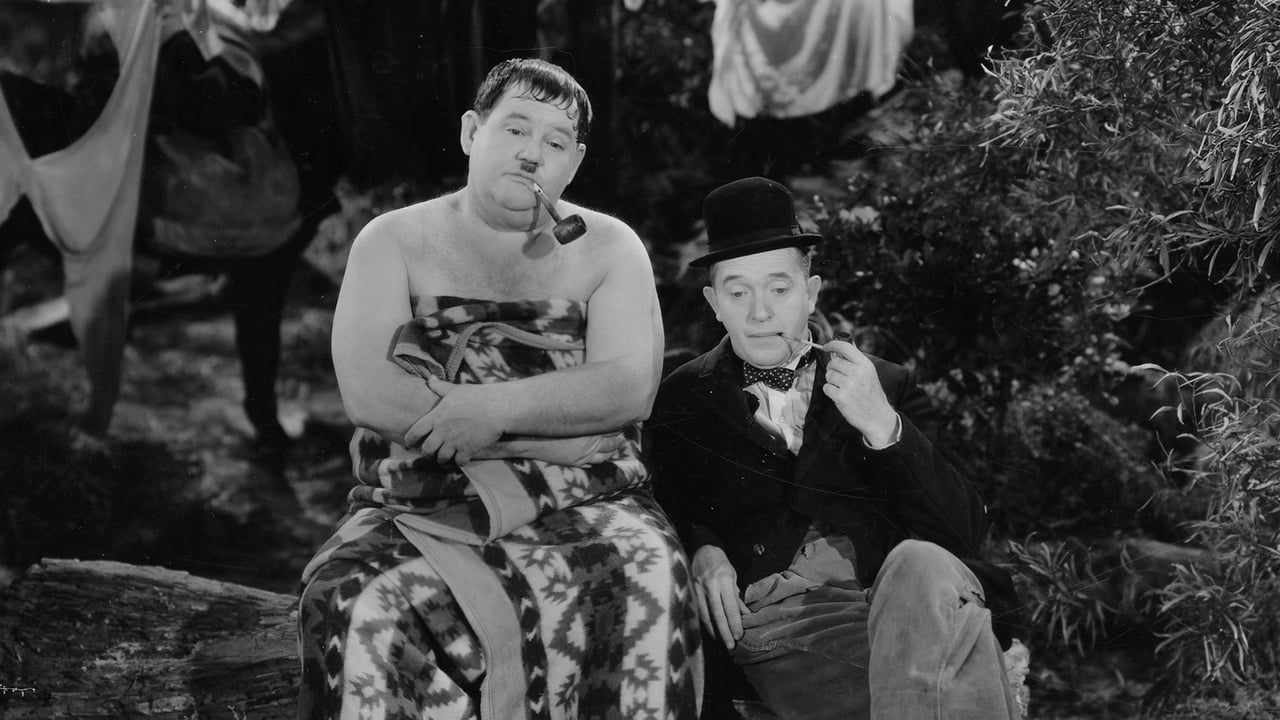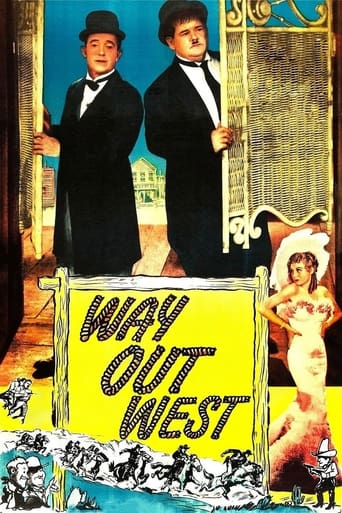

Stan Laurel, Oliver Hardy (themselves), James Finlayson (Mickey Finn), Sharon Lynne (Lola Marcel), Stanley Fields (sheriff), Rosina Lawrence (Mary Roberts), James Mason (anxious patron), James C. Morton, Frank Mills, Dave Pepper (bartenders), Vivien Oakland (stagecoach passenger/Molly, sheriff's wife), Harry Bernard (man eating at bar), Mary Gordon, May Wallace (cooks), Avalon Boys Quartet: Chill Wills, Art Green, Walter Trask, Don Brookins (themselves), Jack Hill (worker at Mickey Finn's), Sam Lufkin (stagecoach baggage man), Tex Driscoll (bearded miner), Flora Finch (Maw, miner's wife), Fred "Snowflake" Toones (janitor), Bobby Dunn, John Ince, Fritzi Brunette, Frank Montgomery, Fred Cady, Eddie Borden, Bill Wolf, Denver Dixon (aka Art Mix), Ben Corbett, Buffalo Bill Jr (aka Jay Wilsey), Cy Slocum (audience at saloon), Lester Dorr (cowboy), "Dinah" the mule, and Ham Kinsey (double for Mr Laurel), Cy Slocum (double for Mr Hardy), Chill Wills (basso voice dubber for Mr Laurel), Rosina Lawrence (falsetto voice dubber for Mr Laurel). Directed by JAMES W. HORNE. Photographed by Art Lloyd and Walter Lundin. Photographic effects by Roy Seawright. Edited by Bert Jordan. Story by Jack Jevne and Charles Rogers. Screenplay by Charles Rogers, Felix Adler, and James Parrott. Musical score and direction by Marvin Hatley. Sound by William Randall. Art direction by Arthur Royce. Songs: "Trail of the Lonesome Pine" (Hardy and Laurel) by Harry Carroll and Ballard MacDonald; "Commence to Dancing" (sung by the Avalon Boys, danced by Hardy and Laurel) by J.L. Hill. Additional background music composed by LeRoy Shield, Egbert Van Alstyne, Nathaniel Shilkret, Irving Berlin, Franz von Suppe, Eddie Leonard, Eddie Munson. Set decorator: William L. Stevens. Make-up: Jack Dawn. Production manager: Sidney S. Van Keuren. Producer: Stan Laurel. Executive producer: Hal Roach.Copyright 9 April 1937 by Metro-Goldwyn-Mayer Corp. Presented by Hal Roach Studios. New York opening at the Rialto: 3 May 1937. U.S. release: 16 April 1937. 7 reels. 65 minutes.SYNOPSIS: With the possible exception of Sons of the Desert, which was subtler if not funnier, Way Out West must rank as the best of all the Laurel & Hardy features. Not only is it pure, unadulterated Laurel & Hardy, with no time wasted on subsidiary plotting or romantic or musical "relief", but it is also a first-rate satire of the Western genre. — William K. Everson in "The Films of Laurel and Hardy". NOTES: Marvin Hatley was nominated for an Academy Award for his Music Score, losing to One Hundred Men and a Girl. Tiny Sandford was originally cast as the menacing sheriff, but his scenes were re-shot with Stanley Fields. Uncredited script contributors were Arthur Vernon Jones (in the initial stages) and director James W. Horne. Art Lloyd was the movie's initial photographer.In 1975, a record of Laurel and Hardy's "Trail of the Lonesome Pine" duet was lifted from the sound track and issued in the United Kingdom and Eire. It proved astonishingly popular, eventually making it right up to the number two spot on the Hit Parade charts, grossing well over £1 million in record sales. The song provided by the Avalon Boys quartet is usually given as the 1905 hit, "At the Ball, That's All", which Laurel and Hardy "Commence to Dancing". Sharon Lynne, accompanied by a chorus of saloon cuties, also has a song, "Won't You Be My Lovey Dovey?" At the fade-out, Laurel, Hardy and Rosina Lawrence chortle "We're Going To Go Way Down To Dixie". The film commenced shooting on 27 August 1936, winding up in early November. COMMENT: One of the funniest of the features, and one of the most suitable for modern viewing as it is not disfigured by some of the vicious tit-for-tat nonsense that L & H often indulged in. The pace is fast, and the music score for once is not only apposite, it's actually a major asset. The boys do a delightful little jig as they listen to the Avalon Boys, and later chorus it up at the bar. The saloon girls' songs are a delight too. The dialogue is funny, the situations amusing. L & H and the entire cast, particularly Sharon Lynne, play with gusto. Hardy's side expressions are a joy.The concluding shots of the present TV prints have for some reason been cut, so that Hardy no longer steps into the pot-hole — which spoils the cumulative effect of one of the film's principal running gags.Impossible to split the photography credit (one doubtless did locations). Horne's direction is more accomplished than usual.
... View MoreA personal note before reviewing this movie proper: I first watched this as a kid in 1979 at the East Baton Rouge Parish Library (a building which was torn down last year to be replaced by another one with the same name) when the place showed old movies every Saturday. I only saw part of it then but what I saw was pretty funny. Then I saw it again, weeks later, at the same place-this time the entirety of it-and it was really funny! This was my first viewing of a Laurel & Hardy film. The thin English one and the heavyset one from Harlem, Georgia were hilarious to watch for me at the time so as a result, they became my favorite comedians to this day. Their arrival in a western town is to deliver a deed-from her late father-to a woman named Mary Roberts (Rosina Lawrence). But since they've never seen her before, Mickey Finn (L & H regular James Finlayson) passes his wife, saloon singer Lola Marcel (Sharon Lynne) as her. I'll stop there and just say after rewatching this on YouTube, this is still quite a hilarious outing for the boys whether, among other things between them, getting chased by the Finns or doing their dance to a tune by The Avalon Boys or even when they're singing and Stan suddenly changes voices mid-song! This was funny mostly from beginning to end. So on that note, I highly recommend Way Out West.
... View MoreIn childhood this was one of my favourite Laurel & Hardy films, and seen with the eyes of an adult it is still packed with an incredible amount of funny moments. L&H arrive in a wild western town to deliver the deeds of a gold mine to Mary Roberts (Rosina Lawrence) a young girl working as a scullery maid for wily saloon owner Mickey Finn (James Finlayson) and showgirl Lola (Sharon Lynn). Finn and Lola trick the boys into handing the deeds over to them and, once they discover the duplicity, the duo are determined to retrieve it.For a full-length feature, it is surprising how well-paced the film is - especially in the first forty minutes (things go downhill a little in the last 20 minutes, although there are still laughs to be had). There are any number of not only funny but classic scenes, such as the pair's impromptu dance to The Avalon Boys song and their duet on Trail of the Lonesome Pine (which would reach the top of the charts long after the boys had both died), Stan's hysterics as Lola tries to wrestle the deeds from him, Ollie's frustrated attempts to emulate Stan's thumb trick, and Stan finding he quite enjoys the taste of Ollie's hat, etc.This is arguably one of Laurel & Hardy's greatest films and is essential viewing for anyone interested in vintage Hollywood comedy.
... View MoreWhat did Rosina Lawrence's dying father expect when he entrusted Stan Laurel and Oliver Hardy to deliver the deed to a gold mine to her in Way Out West? I mean even in death was his judgment that seriously impaired?The boys are up to the necks in it in the town of Brushwood Gulch when they try to do their good deed. In fact Ollie's up to it even before as Stan innocently dumps the freeloading Ollie who is snoozing in a travois drawn by their donkey while Stan is guiding the poor animal. Dumps Ollie in a creek mind you. Serves him right actually.The boys arrive in town and wouldn't you know it, they tell bartender James Finlayson what their mission is. So the quick thinking Finlayson gets his wife Sharon Lynne to pose as Lawrence and the boys sign the deed over to her. Later on they discover their mistake and the rest of the film is spent trying to make up for their mistake and get the deed to the rightful owner. Of course it's one mishap after another, including Stan lighting Ollie's thumb on fire. Don't ask how.Everybody looks like they're having a great old time in Way Out West. Finlayson is a terrific Snidely Whiplash, Lynne does a great imitation of the kind of brassy dame that Gladys George or Binnie Barnes had a specialty in, and Lawrence is a fabulous little Nell heroine. Way Out West is one of Stan and Ollie's best feature film comedies. It even got an Oscar nomination for Best Musical Scoring. But I still wonder, wasn't their anyone else Lawrence's father could get for such a mission?
... View More